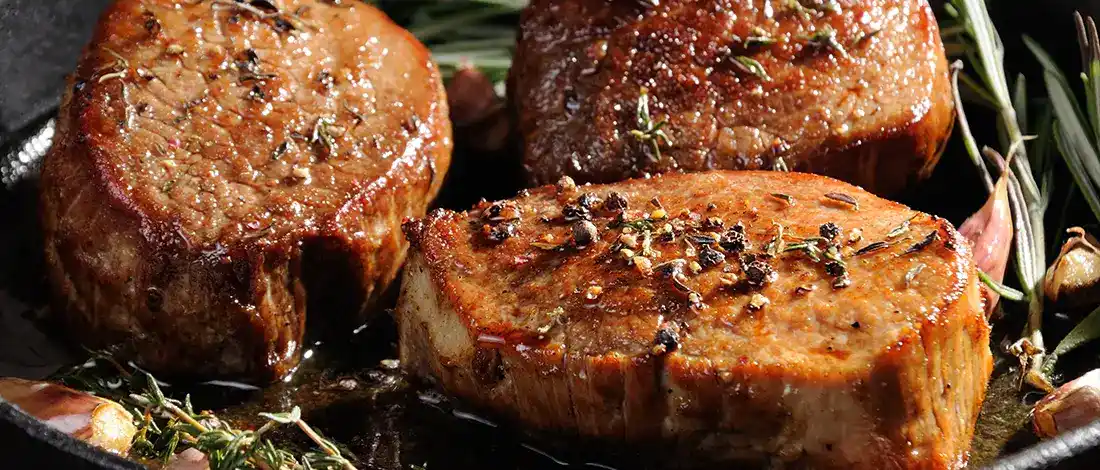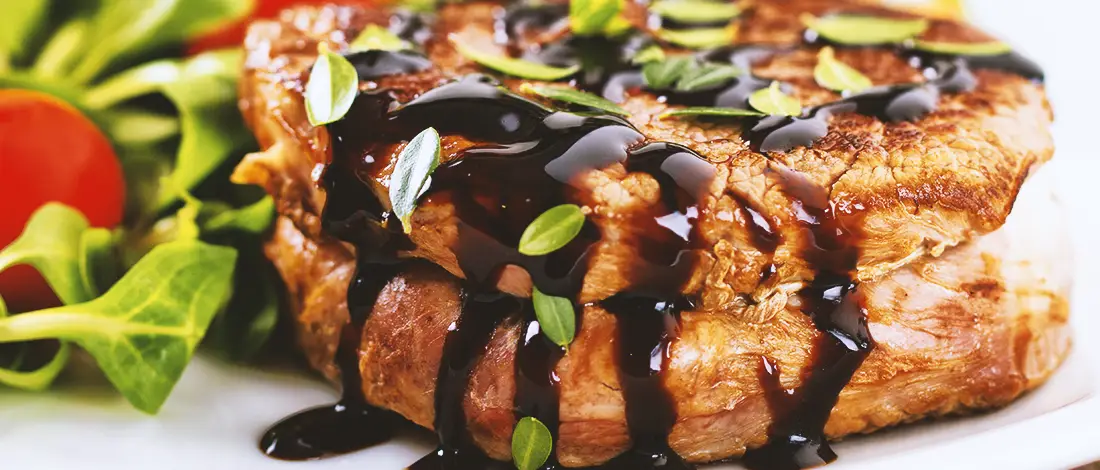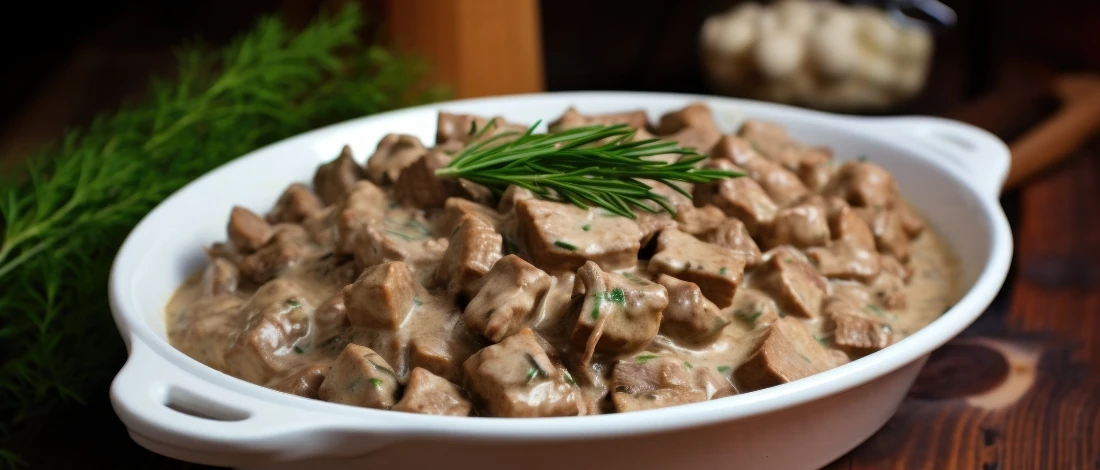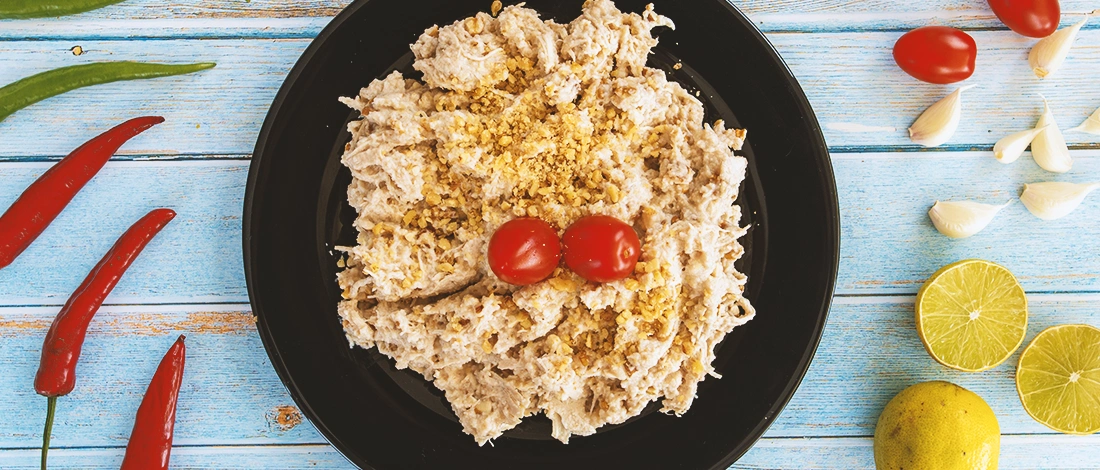Among the many cuts of beef I’ve eaten on my carnivore diet, filet mignon stands out as an excellent option. As a long-time follower of the carnivore diet, I appreciate how filet mignon can help me meet my nutritional needs while following this lifestyle.
I talked to my local butcher to find out what filet mignon is, and I also did some web-based research to check its full nutritional profile.
Here’s what I found.
Quick Summary
- Filet mignon is a tender cut of beef taken from the smaller end of the tenderloin, known for its tenderness and mild flavor.
- High in protein, filet mignon provides essential vitamins and minerals.
- According to a 2019 post from FoodData Centrail, filet mignon contains just 24.6 grams of fat and 85 milligrams of cholesterol, which makes it a reasonable option for those looking to reduce their intake of bad fats and cholesterol.
- Filet mignon is usually more expensive than other cuts in restaurants.
Where Does Filet Mignon Come From?
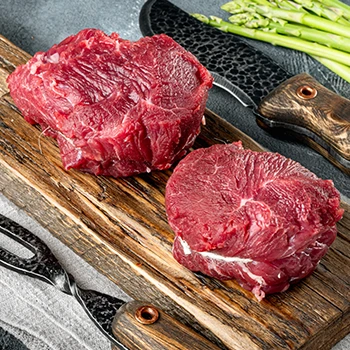
Filet mignon comes from the tenderloin’s small end and has no bone. It is a luxurious cut of beef that has become a staple in upscale steakhouses.
The filet mignon cut is taken from the psoas major muscle that resides underneath the ribs on the back of the cow. This is the most tender cut of any muscle. It has very little connective tissue or fat.
The beef tenderloin is prized for its juicy, fine-grained texture and succulent flavor, making it a tender cut and sought-after steak. To create filet mignon, the tip of the tenderloin is divided into small, rounded-off portions.
Filet mignon is rare because beef cattle have only two tenderloins, which yield two to four filets. In fact, an entire 1,200-pound steer will only provide about 740 to 770 pounds of meat, out of which ~2 pounds is filet mignon [1].
This is why it is typically more expensive than other cuts of meat. This is particularly true with grass-fed beef, like wagyu filet mignon from Japan.
"Filet mignon is one of the most exquisite cuts of beef and it has to be cooked with skill, love, and attention."
- Alex Guarnaschelli, Chef
Although the name filet mignon is French, in France, it refers to a pork tenderloin dish.
They call this beef cut "filet de bœuf." Other names used for filet mignon are fillet steak and eye fillet.
Cuts of meat like a porterhouse steak, sirloin, strip steak, T-bone, or ribeye will be more marbled with fat than a filet mignon.
This yields a beefier steak flavor than the delicate filet mignon taste.
Cooking Filet Mignon
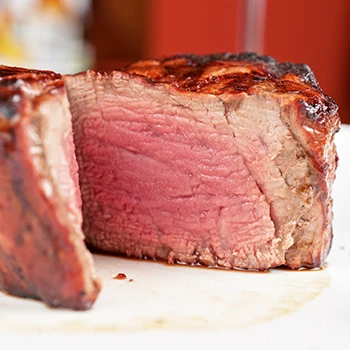
Due to its cost, filet mignon has obtained a reputation for being an exclusive delicacy found only at high-end restaurants. Although you most often find it at a fine steakhouse, you can cook a filet recipe in your own kitchen.
Because filet mignon has little fat or connective tissue, most people prefer a filet cooked medium-rare rather than a well-done steak.
Unlike a sirloin or ribeye, if filet mignon is cooked too long, this lean meat is no longer tender, even when sliced against the grain.
The two most common cooking methods to prepare a perfectly cooked filet mignon steak are grilling it or sewing it in a pan or skillet on the stovetop.
1. Cooking Filet Mignon on the Grill

Grilling filet mignon is easy and yields a delicious result. For added tastiness, sprinkle your steaks with a mixture of salt, garlic powder, and onion seasoning on both sides.
- Preheat your grill to medium-high heat; if you use charcoal or wood, wait until the fire has died down before grilling. Place your steaks directly over the heat source for about five minutes per side; flip them once and roll the edges to get a browned crust all over.
- Once they're browned enough, move them to a lower heat part of the rack and cover them with a lid. This will allow them to finish cooking through without burning on the outside while still producing that delicious smoky flavor.
- Cook until you reach an internal temperature of 135 degrees Fahrenheit (medium-rare) on your instant-read meat thermometer. For a well-done steak, cook to an internal temperature of 145 degrees. But be careful not to overcook the meat.
- When they are at your desired doneness, remove the delicious filet mignon from the grill onto a platter and let them rest for 10 minutes before serving. This will maintain the tenderness as the filet cools. Then, slice the meat against the grain.
2. Searing Filet Mignon
Another popular way to cook filet mignon is by searing it in a hot pan or skillet.
- To begin, ensure that the filet mignon steaks are thick, firm, and at room temperature. Then, season generously with any desired spices.
- Heat 2-3 tablespoons of butter or olive oil in the pan over medium heat. Once the fat melts, carefully place your steak in the skillet.
- Shift to high heat and sear both sides of the steak for approximately two to three minutes each. For maximum beefy flavor, it is essential to ensure that the surfaces of the steak are in direct contact with the hot pan while it cooks.
- Remove the filet mignon, tent with tin foil, and let rest for ten minutes before you serve the meat.
Related Articles:
What Is the Best Way to Serve Filet Mignon?
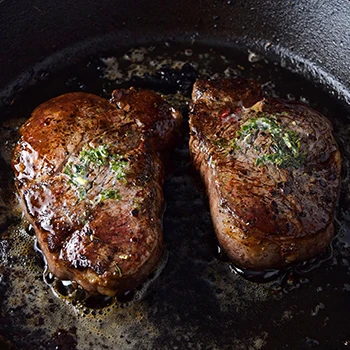
The best way to serve filet mignon is with traditional butter-basting. Alternatively, additional flavoring can be added with a béarnaise sauce or red wine reduction. Items like garlic butter or sautéed mushrooms can make excellent garnishes, too.
Before cooking, a classic filet mignon recipe will wrap the meat in bacon for a tasty and visually appealing presentation.
A full meal can be made by pairing filet mignon with side dishes that go well with a good steak. These include roasted vegetables, baked potatoes, mashed potatoes, or salads.
Other accompaniments may include:
- Fresh herbs like thyme, rosemary, or parsley.
- Cheeses such as parmesan.
- Grains like couscous or quinoa.
- Legumes like lentils.
- Other seasonings, like crushed red pepper flakes or Dijon mustard.
Nutrition and Health Benefits
A lean cut filet mignon is a good source of nutrition. A 100-gram serving (without any sauces) is:
- Low in fat and cholesterol: According to a 2019 post from FoodData Centrail, filet mignon contains just 24.6 grams of fat and 85 milligrams of cholesterol, which makes it a reasonable option for those looking to reduce their intake of bad fats and cholesterol [2].
- High in protein: A serving of filet mignon has about 23.9 grams of protein, which can help boost metabolism and build strong muscle tissue.
- Rich in B vitamins: B vitamins promote energy production and proper nerve functioning. Filet mignon is a good source of several B vitamins, including thiamine, riboflavin, niacin, vitamin B6, and folate.
- Source of minerals: Filet mignon also provides minerals like zinc, phosphorus, magnesium, and iron that are important for aiding digestion and supporting the immune system.
Where Is the Best Place to Buy Filet Mignon?

The best place to buy filet mignon is in specialty butchers or online outlets. Because filet mignon is a relatively rare item, it may not be easy to find, even in the local butcher shop.
When purchasing, look for steaks of even thickness that are juicy and bright red in color; avoid any with an odor.
The USDA grade is also important; choose steaks labeled "prime" for the most tender option. You can also choose a wagyu filet mignon from Japan that is rated A5.
Lastly, check the sell-by date to ensure that the steaks are fresh enough to eat. Keep them in the freezer or fridge until you are ready to cook and serve them for dinner.
Read More: Prime vs Choice Beef
Filet Mignon With Herb Butter
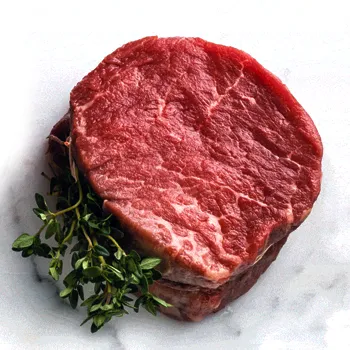
As I said, the best way to serve filet mignon is with traditional butter-basting. That's why I've crafted this recipe that'll surely wow every palate.
Ingredients:
For the Filet Mignon
- 2 6-oz Filet Mignon
- 2 Teaspoons of Kosher Salt
- 1 Teaspoon of Pepper
- 2 Teaspoons of Avocado Oil
For the Garlic Herb Butter
- 3 Tablespoons of Grass-Fed Butter (softened and divided)
- 1 Glove of Garlic (minced)
- 4 Teaspoons of Finely Chopped Herbs (fresh rosemary, parsley, and thyme)
- ⅕ Teaspoon of Kosher Salt
Instructions
- Remove your steak cuts from the fridge 30 minutes before cooking to bring them to room temperature.
- Mix together the butter, garlic, salt (if using plain butter), and herbs in a small bowl to make the garlic butter. Form into a log and place in the fridge.
- Preheat the oven to 400ºF.
- Pat dry the mignon with a paper towel and season with salt and pepper.
- Preheat your cast-iron skillet over medium-high heat until scorching hot. Add the avocado oil (or butter) to the pan.
- Place the steaks into the skillet and sear on both sides for 2 minutes. Do not move the steaks around while cooking, or you will disrupt the sear.
- Remove the meat from the pan and place it into an oven-safe skillet. Place it into the preheated oven and cook for 6 minutes to achieve medium-rare. Let the steaks rest for 5 - 8 minutes.
- Top the steaks with 1 ½ tablespoons of herb butter, cut, and serve.
If you don’t like garlic, you can skip adding it to the herb butter, and it’s just as tasty without it.
Cook the steaks in the oven for:
- 5 minutes - Rare
- 7 minutes - Medium
- 8 minutes - Well done
When you let the meat rest, it will rise by another 5ºF.
FAQs
What Is a Cheaper Version of Filet Mignon?
The shoulder tender, also known as the teres major, is a cheaper version of filet mignon but still provides excellent flavor. This steak comes from the cow's beef chuck or shoulder and is quite juicy and tender when cooked properly.
What Is the Main Difference Between Steak and Filet Mignon?
The main difference between steak and filet mignon is the cut of meat. Steak can be any thick cut of beef, while filet mignon is a specific cut taken from the beef tenderloin or short loin region.
Is Filet Mignon Overrated?
Many chefs feel that filet mignon is overrated. The lack of marbling and fat can reduce the flavor and make it more prone to drying. That is why butter or oil is often added during cooking to compensate.
Is Wagyu Filet Mignon Worth It?
Yes, wagyu filet mignon is worth it. It is one of the best premium cuts because it has more intra-muscular marbling compared to the other cuts.
Is Filet Mignon Steak the Best?
A large number of people feel that the filet mignon steak is the best cut of meat available. It has a mild, buttery flavor with the most tender texture. Additionally, its rarity-induced high price also adds to its reputation.
References:
- https://extension.sdstate.edu/how-much-meat-can-you-expect-fed-steer
- https://fdc.nal.usda.gov/fdc-app.html#/food-details/169544/nutrients


